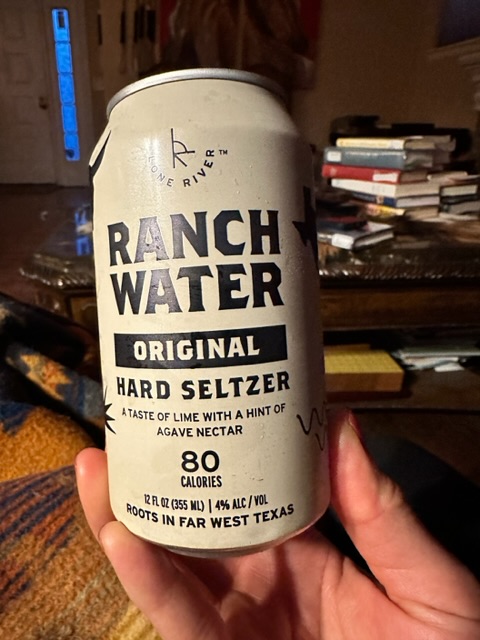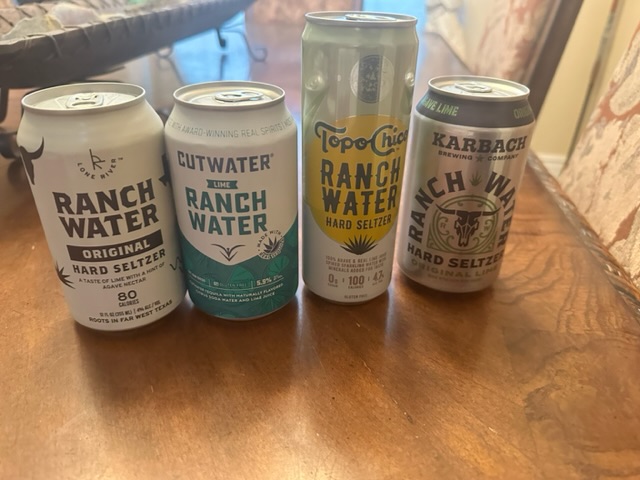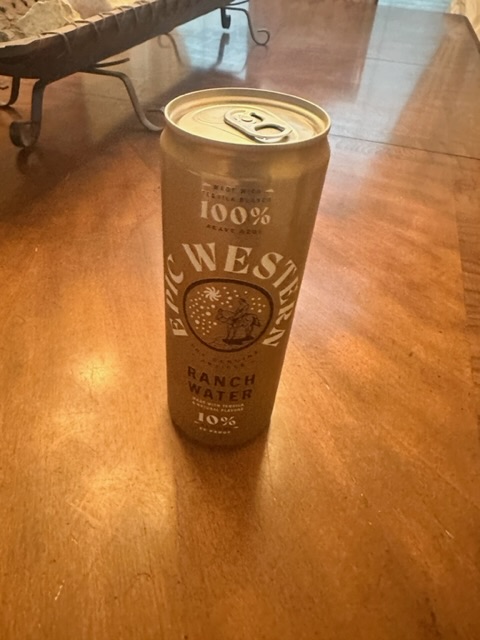 Morgan Weber, a native of eastern Texas and co-owner of Houston’s Agricole Hospitality group (which owns Revival Market, Coltivare and Eight Row Flint) says he first experienced the West Texas favorite at a house party in Marfa two summers ago.“The locals were pouring a sort of crude version of something that seemed half Tom Collins and half Margarita,” Weber says. “[They used] tequila, fresh lime juice, a splash of simple syrup and—the most important ingredient—Topo Chico mineral water. They were calling them Ranch Waters. I didn’t realize at that point that this was a legitimate micro-regional, Texas institutional drink.”
Morgan Weber, a native of eastern Texas and co-owner of Houston’s Agricole Hospitality group (which owns Revival Market, Coltivare and Eight Row Flint) says he first experienced the West Texas favorite at a house party in Marfa two summers ago.“The locals were pouring a sort of crude version of something that seemed half Tom Collins and half Margarita,” Weber says. “[They used] tequila, fresh lime juice, a splash of simple syrup and—the most important ingredient—Topo Chico mineral water. They were calling them Ranch Waters. I didn’t realize at that point that this was a legitimate micro-regional, Texas institutional drink.”
Coincidentally, a few months later, a customer from Odessa sat down at the bar at Coltivare while Weber was working and ordered a Ranch Water–by name. Mere mention of the drink sparked conversation between the two, as the West Texan native recalled growing up drinking Ranch Water with his friends. “There’s a deep love for that drink west of the Pecos River,” says Weber, who was inspired to make his own rendition.
In Austin, Kevin Williamson, owner of Ranch 616, devised his take on Ranch Water about 15 years ago when he casually added mineral water to his glass as his Margarita lessened. He tinkered around with the drink, swapping out silver tequila for an oaky reposado, plus a full ounce of fresh lime juice and a splash of orange cordial. He serves his version with an entire slim glass bottle of the requisite Topo Chico on the side, so that guests can decide the strength and effervescence of their drink.
“With Texas’ close historical connection to Mexico, it makes perfect sense to enjoy a tequila-based beverage with a mineral water from Monterrey,” says Ranch 616’s bar manager, Mark Yawn.
But is a Ranch Water the real deal if it’s not made with Topo Chico? Well, that depends on whom you ask. Diehards only make it with the über-bubbly mineral water, which has been bottled since 1895 and is sourced from an inactive volcano in northern Mexico. While legend has it the nutrient-rich water healed an Aztec princess of a disease no doctors could cure, modern disciples of the elixir praise its unparalleled effervescence and refreshing properties. Now that the water is gaining more and more of a cult following across the States, perhaps Ranch Water fandom will also continue to spread.
When planning the bar menu for Eight Row Flint, which opened in Houston this past winter, Weber wanted to perfect a superior Ranch Water, knowing it would become an instant favorite at the icehouse-inspired hangout. Shockingly, he left out Topo Chico, instead delivering a wealth of bubbles via force carbonation, serving the drink on tap.
His riff is much more complex than the original, starting with the base spirit, which pays homage to the region’s flavors. Weber swaps the tequila for sotol, made from the agave plant’s wild cousin that grows naturally in West Texas and Chihuahua. The lime flavor comes from two distinct sources: clarified lime juice and old-school lime oleo saccharum, a syrup made with lime peels.
“We turned back to our punch-making history of 200 years ago and made a lime oleo saccharum to give [the drink] a good lime-y backbone, and added a touch of salt to accentuate the flavors even more,” says Weber. In a final flourish, he spritzes local Rio Grande grapefruit oil onto the drink for a juicy, fragrant finish.
But the true beauty of a Ranch Water is that it doesn’t have to be gussied up to get the job done. The next time the air gets heavy with heat, pay heed to your southwestern neighbors, who know that liquid relief is just three simple ingredients away.
Texas Ranch Water is a simple, three-ingredient cocktail that is nearly impossible to mess up. Think of it as something like a skinny margarita, but even easier.
How To Make Ranch Water
Fill a glass with ice. Add about three ounces (two shots) of blanco tequila and about an ounce and a half (a shot) of fresh lime juice. Top with Topo Chico. Garnish with a fresh lime wedge on the rim of the glass.
There are as many variations on Ranch Water as there are fans of the refreshing, easy cocktail. Salt or tajin on the rim or inside the drink are popular additions.
“Add a pinch or two of rock salt or something similar — very refreshing,” community member Robert Solis advises. “By the way, I am from Texas and I own a ranch so I know a thing or two.”
Punching up the drink with some added spice is a popular modification, too. “Cowgirls, Try adding a couple of pickled jalapeno slices,” suggests community member Cyoung27312. “Yee haw!”
Ingredients
3 ounces blanco tequila, such as Espolon or Casamigos (about 2 shots)
1 ½ ounces fresh lime juice (about 1 shot)
Topo Chico, chilled
Fresh lime wedge for garnish
Directions
Using a rocks glass—really, whatever glass you have on hand—fill with ice.
Add tequila and fresh lime juice.
Top with Topo Chico. Add fresh lime wedge to the rim of the glass. Enjoy!
|
|
|
Maestro Dobel Diamante tequila is a relative newcomer to the use in 2008. It’s a Jose Cuervo label stretches back to the dawn of tequila distilling. It’s an ultra-luxury brand. It’s blended claro, meaning they’ve blended Resposado and Anejo tequilas, then filtered them back to the barrel notes and a near clear color. They are calling it a blanco with a resporado taste.
Another to try, made from 100% Blue Weber Agaves in Jalisco, Mexico, is Kendall Jenner’s award-winning 818 Tequila. A real people pleaser, 818 is a pleasure to drink, it’s naturally sweet, balanced, and super smooth working as both a great sipping and mixing tequila.
Our friend who is a distributor recommended Avion Reserva which is an awesome $150 tequila.
Look for brands that don’t use the diffusion method.
Diffusion method basically enables distilleries to produce large amounts of juice (tequila) in half the amount of time using half the amount of pinas.
Patron, Don Julio, Forteleza, Herradura and Cimarron are a few brands that still utilize traditional cooking methods. These brands, in comparison to others that use diffusion, have a smooth/full mouth-feel and taste earthier/more vegetal.
If you get the chance to compare Patron to Jose Cuervo, dab some of the spirits on your hand and let it dry. Once dried, smell your hand. You can literally smell the difference.
That explains why my Gold Jose Cuervo was a lot more harsh to the taste than the Patrón. I just need something that is in the same price range as Patrón with the same “smooth” and less harsh taste as Patrón to get my friend to realize that there is more to tequila than just Patrón.
Jose Cuervo Gold is disgusting because it hardly qualifies as tequila. It’s made with only 51% agave and 49% grain alcohol.
Tequila quality can be complex topic, but at a bare minimum anything that doesn’t say 100% Agave anywhere on the bottle should be avoided at all cost.
An overly simplified example of Cuevro Gold would be: adding 1 shot of Tequila and 1 shot of vodka into a glass and then adding a few more small drops of Tequila in the same glass. That way, it is at least 51% Tequila and can therefore be labeled “Tequila” on the bottle but it won’t say 100% agave.
They are called “Mixtos” the Tequilas that don’t contain 100% agave. Mixtos aren’t very common at the store aside from Cuervo but a lot of regular bars will use random no-name Mixtos as their well Tequila.
Even 100% Agave can be misleading with the really cheaper priced bottles. You’ll see the term “diffusor” thrown around this sub, but that is a little more complex subject. A lot of the really cheap bottles mainstream bottles will be 100% agave, but made via diffusor. El Jimador, Sauza, Camarena, Cazadores are the most common bottles you’ll find on nearly all store shelves. Just stay away from anything not 100% agave, and stay away from Jimador, Camarena, Cazadores and Sauza. Other than that, just try different bottles to see if you figure out what kind you tend to like.
There are a very small number of mixtos that are excellent. The San Matias Grand Reserve XA is 70% / 30% in Mexico as taste tests indicated that is what the Mexican market preferred. There is one other whose 70/30 mix regularly beats out very well made tequilas in blind taste tests. But, yeah, mixtos, by rule, are nasty paint thinner that is only good for cleaning white boards.
Olmeca Altos Blanco or Reposado is very nice and twice cheaper than Patron.
Most people that are into tequila for what it is don’t look for “smoothness” to determine a good tequila. However I can see the appeal of it and it is often said “Patron is tequila for people who don’t like tequila. ” With that being said, I believe that if you like a particular style then no one should tell you differently. Cristalino tequilas are what you are after. There’s some interesting ones coming out recently as it is a new trend in Guadalajara right now. I haven’t seen much variety in the US as in Mexico but that is to be expected.
Cristals aren’t really that popular among aficionados. Basically, a cristaliano tequila is an aged product that has an extra filtration step. Take an Anejo or XA, filter it– oft through active carbon– and it is a cristiliano. Not only does the filtering take out all the color, it takes out a bunch of flavor too. The end result is a tequila that is very “soft” and, yes, “smooth”. The sharp, oft very desirable, flavors of an aged product tend to be muted if not missing altogether. For some products– DJ 70– they start with a decent enough aged product and filter it. For others, “cristiliano” translates to “our aged product tastes like ass, so we filtered it, sell it as a cristiliano, and charge a premium”.



